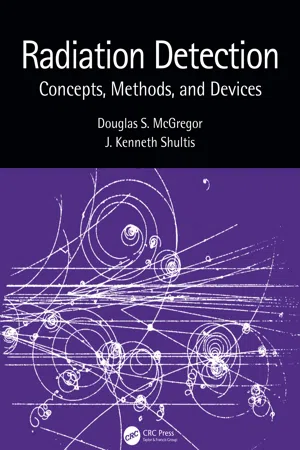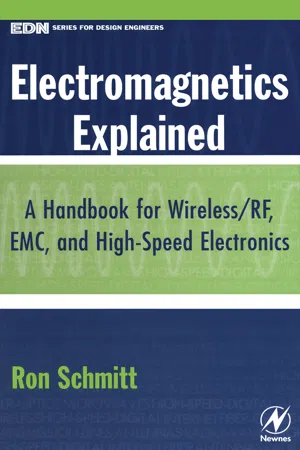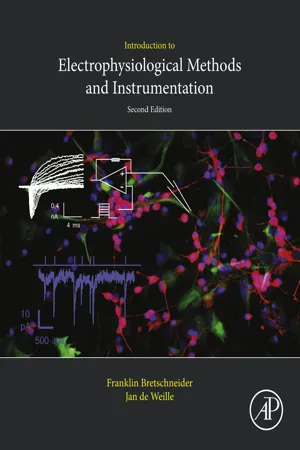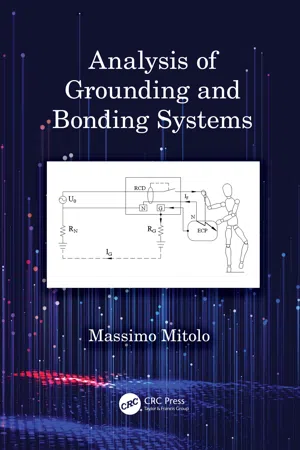Physics
Electric Potential due to a Point Charge
The electric potential due to a point charge is a measure of the potential energy per unit charge at any point in the electric field created by the charge. It is calculated using the formula V = kQ/r, where V is the electric potential, k is Coulomb's constant, Q is the charge, and r is the distance from the charge. The electric potential is a scalar quantity and is measured in volts.
Written by Perlego with AI-assistance
8 Key excerpts on "Electric Potential due to a Point Charge"
Learn about this page
Index pages curate the most relevant extracts from our library of academic textbooks. They’ve been created using an in-house natural language model (NLM), each adding context and meaning to key research topics.
- eBook - ePub
Radiation Detection
Concepts, Methods, and Devices
- Douglas McGregor, J. Kenneth Shultis(Authors)
- 2020(Publication Date)
- CRC Press(Publisher)
potential, which is defined as the potential energy per unit charge,V =U=Q ′14 πϵ o∑i = 1n,Q ir i(8.16) and is expressed in units of volts (or joules per coulomb). Note that the potential is no longer dependent upon the “test” charge Q′ .3 The force exerted upon Q′ may also be expressed in terms of the electric field, produced by one or more point charges, in whichF =. Substitution ofQ ′Einto Eq. (8.13 ) and division by Q′ gives the potential difference between two points within the electric field. Hence, the potential difference between arbitrary locations a and b isq ′EV= Δ V =a b∫ a bE ⋅ d l =∫ a bE cos θ d l .(8.17) In summary, Eq. (8.17 ) is the voltage that an experimenter would measure between two points (a and b) within an electric field. The work done on a unit test charge moving from some point a to another point b in the electric field is Q′ Vab.8.3CapacitanceConsider the arrangement depicted in Fig. 8.6 . Two conductive plates, separated by a distance d, have equal, but opposite, charges. An electric field is produced between the plates by the charges on the plates. The positively charged plate (or terminal) has a voltage V1 and the negatively charged plate has a voltage V2 . The capacitance of the two plates is defined as the ratio of the charge magnitude on either plate to the magnitude of the potential difference between the plates,C =|.Q|Δ V(8.18) If ΔV is taken as the applied voltage V between the electrodes, then the above definition gives the important relationC V = Q(8.19) The SI unit for capacitance is the farad (one coulomb per volt). The reader should understand that the charge stored in a capacitor has a summed positive charge on one terminal and an equal summed negative charge stored on the opposite terminal; hence, a capacitor with stored charge Q actually has +Q on one terminal and −Q - eBook - ePub
Electrical Engineering
Fundamentals
- Viktor Hacker, Christof Sumereder(Authors)
- 2020(Publication Date)
- De Gruyter Oldenbourg(Publisher)
φ of the field at that point.Defining equation:φ =W pQ +1.9 Voltage V
Voltage is the difference in electric potential between two points. In a static electric field, voltage is defined as the work needed to move a unit charge between two points.The necessary charge to transport a chargeQ +from object 1 to object 2 equals the difference of the potential energiesof the charges on the two objects.W=1 , 2W−p , 2Wp , 1The potential difference equals the work for the unit charge:Q += 1 A sφ 2−φ 1=WQ1 , 2It is called voltage V (14 ).Defining equation:V =W1 , 2Q +V = V15 SI unit:V o l tV =JA sThe voltage between two objects therefore is the work that is necessary to transport the unit chargefrom the negatively charged object to the positively charged object. If this voltage is expended, the charges are separated.Q += 1A sVoltage can cause electric current: If there is a voltage between two particles and these two particles are connected through a conductor, current flows. (More specifically: There is an electric field between the two particles. This field exerts force on the free charge carriers, which causes them to move.)Voltage is connected to force: - eBook - ePub
- Adrian Waygood(Author)
- 2018(Publication Date)
- Routledge(Publisher)
potential’ .The absolute potential at any point along a line of electric flux is defined in terms of the work done in moving a negative charge (in Figure 5.4 , a single electron but, in practice, a negative charge equal to one coulomb) from infinity to that particular point (point B ).Unfortunately, this is not a very practical definition for potential – after all, ‘infinity’ is hardly ‘accessible’!Figure 5.4So, instead, we choose an accessible , but arbitary, point of reference – such as point A in Figure 5.4 – and then find the work done in transporting the charge from that point to point B . In other words, we determine the potential at point B with respect to point A .Or, to put it another way, it allows us to determine the potential difference between points A and B .The potential difference between two points in an electric field is defined in terms of the work done in transporting electric charge between those two points.The term ‘voltage ’ is synonymous with ‘potential difference’ (but not potential) – i.e. they both mean exactly the same thing! The symbol for potential difference or voltage is E , U or V - eBook - ePub
Electromagnetics Explained
A Handbook for Wireless/ RF, EMC, and High-Speed Electronics
- Ron Schmitt(Author)
- 2002(Publication Date)
- Newnes(Publisher)
* Without any aether, there is no way to measure absolute velocity. All movement is therefore relative.Figure 2.2 Two balls attached by a spring. The spring exerts an attractive force when the balls are pulled apart.VOLTAGE AND POTENTIAL ENERGY
A quantity that goes hand in hand with the electric field is voltage. Voltage is also called potential, which is an accurate description since voltage quantifies potential energy. Voltage, like the electric field, is normalized per unit charge.Voltage = Potential energy of a unit chargeIn other words, multiplying voltage by charge gives the potential energy of that charge, just as multiplying the electric field by charge gives the force felt by the charge. Mathematically we represent this byPotential energy is always a relative term; therefore voltage is always relative. Gravity provides a great visual analogy for potential. Let’s define ground level as zero potential. A ball on the ground has zero potential, but a ball 6 feet in the air has a positive potential energy. If the ball were to be dropped from 6 feet, all of its potential energy will have been converted to kinetic energy (i.e., motion) just before it reaches the ground. Gravity provides a good analogy, but the electric field is more complicated because there are both positive and negative charges, whereas gravity has only positive mass. Furthermore, some particles and objects are electrically neutral, whereas all objects are affected by gravity. For instance, an unconnected wire is electrically neutral, therefore, it will not be subject to movement when placed in an electrical potential. (However, there are the secondary effects of electrostatic induction, which are described later in the chapter.)Consider another example, a vacuum tube diode, as shown in Figure 2.3 - eBook - ePub
- Wai Kai Chen(Author)
- 2004(Publication Date)
- Academic Press(Publisher)
b . The potential function is thus a single-valued point-wise continuous function everywhere in space, even in the presence of material boundaries. Therefore:(2.18)The quantity measured by equation 2.17 is called the electromotive force (emf) in the path a–b , or the potential difference or voltage difference between the points a and b measured in volts.The second equation of equations 2.16 can be used to derive the relationship between the electrostatic potential and the electric charges inside an infinite homogeneous space by recognizing that:Thus:(2.19)where, as is customary, the potential at infinity = 0 has been defined; thus, Φ0 = 0, and Φ(r ) is the absolute potential.Thus, the potential of a point charge, or monopole, is simply:(2.20)To calculate the electrostatic field of any charge distribution, equation 2.19 can be used first to calculate the electrostatic potential by integration over the source, and then the vector electric field can be derived from its gradient. By this process, the potential on the axis of the charged ring of Figure 2.4(A) is easily obtained. Then, the on-axis potential of the disk follows by integration over a continuum of rings, as before. The results are given in Table 2.2 . Constructing a spherical shell by integrating over a series of rings spanning the surface of a sphere (θ = 0 to π) yields the potential of a spherical shell of surface charge density σ and radius a. A similar derivation yields the potential of a uniformly charged sphere. These are also included in Table 2.2 .The potential function for ensembles of point charges is particularly simple, even in the near field. Thus, for an observation point anywhere near the dipole of Figure 2.5 , the total potential is given as the scalar sum of the two point source potentials, shown at the bottom of Table 2.2 . The latter discussion naturally applies to the case of two-dimensional charge distributions. In two dimensions, however, the electrostatic potential suffers an ambiguity from the infinite length of the structures in that the potential at infinity becomes undefined. The solution is to always calculate the potential of pairs of equal and oppositely charged line charges so that the net charge is zero and so that the potential at infinity is exactly zero. Thus, at an observation point a distance r 1 from a positive line charge and a distance r 2 from an equal and opposite line charge, the potential is as given at the end of Table 2.2 - eBook - ePub
- Allen J. Bard, Roger Parsons, Joseph Jordan(Authors)
- 2017(Publication Date)
- CRC Press(Publisher)
Chapter 1 .However, the classical definition of potential causes difficulty as soon as an attempt is made to consider the potential difference between two points in different media: for example, between a point in vacuum and a point in a condensed phase. This may be made clear by noting that the energy change in taking a test charge from one point to the other depends on the nature of the test charge because of the short-range “chemical” interaction between the test charge and the condensed phase. There is no complete solution to this problem because there is no method for the separation of “chemical” and “electrical” forces since they are both essentially electrical in nature.Nevertheless, some useful separations can be carried out on the basis of well-defined operations either on the real system or on a simple model of it. In the former case the quantities obtained are measurable, in the latter they are calculable in principle. These two cases can be illustrated first using the simple system of a piece of conducting material β of uniform bulk composition surrounded by free space. The work of inserting a charged particle of species i from a point distant from the conductor into a point in the bulk of the conductor is the electrochemical potential. This is a measurable quantity that depends on the nature of the phase β, on the nature of the charged particle i, and on the state of charge of β. Experimentally, it is possible to reduce the electrostatic charge on β to zero. This may be verified by the absence of a field in the free space around β. Under these conditions the electrochemical potential takes a particular value which has become known as the real potentialu ˜i βα i β. The best known example of a real potential is the electronic work function. (Since the latter is a work of extraction, not a work of insertion, it is−α e β - Franklin Bretschneider, Jan R. de Weille(Authors)
- 2018(Publication Date)
- Academic Press(Publisher)
Electrophysiology is the field of research on electrical processes in living creatures. This includes everything from current flow through wires to signals in our instruments to electrochemical processes, in living cells and organs, and in the electrodes we use to study them. So, although most of the vast field of electricity theory is outside the scope of this book, we need to deal with a handful of quantities that play important parts, such as charge, voltage (potential), current, resistance, impedance, and especially their complicated changes in time. We start with the main definitions and the relationships between these quantities.Electric Charge, Current, and Potential
The basic quantity is the electric charge, buried in the atomic nucleus as what we call a positive electric charge and in the electrons surrounding it, which we call negative charge. The unit of electric charge (abbreviated Q) is the coulomb (abbreviated C), defined in (macroscopic) electric circuits in the 18th century.The underlying fundamental constant, found much later (in 1909, by R. Millikan), is the elementary charge, the charge of one electron, which amounts to 1.6021 × 10− 19C. Since this “quantum of electricity” is so small, most electric phenomena we will describe may be considered as continuous rather than discrete quantities.By the nature of atoms, most substances, and indeed most materials in daily life, are neutral. Obviously, this does not mean that they have no charges at all, but that (1) the number of positive charges equals the number of negative charges and (2) the opposite charges are so close together that they are not noticeable on a macroscopic scale. This means that a number of substances can be “teased” to release electricity, e.g., by rubbing them together. This was indeed the way electricity was discovered in antiquity and was examined more systematically from the 18th century on. Many science museums are the proud owners of the large static electricity generators invented by among others van Marum and Wimshurst. These machines generated rather high voltages (around 50 kV), but at very low current strengths (1 μA), and so were not of much practical use.Nowadays, most sources of electric energy are electrodynamic, made by rotating machines such as the generators in our power plants, in cars, and on bicycles.These machines can produce almost any voltage and current needed, usually as alternating current (AC) that can be transformed into lower or higher voltages as desired. In addition, electrochemical processes, found originally by Galvani and Volta, are employed in the arrays of galvanic cells we call batteries and accumulators. Both forms of source deliver the electrical energy at lower voltages (say, 12- eBook - ePub
- Massimo Mitolo(Author)
- 2020(Publication Date)
- CRC Press(Publisher)
→ is constant over such equipotential surfaces, and would decrease if we considered surfaces at greater distances from the center of the electrode.Thus, the electric fieldcan be calculated as:E →( r )E →( r )= ρJ →=ρI G2 πr 2r ^(2.2) Thus, the above defined potential difference V (r ) is:V( r )= ρI G2 π∫ r ∞1d r = ρr 2I G2 π= ρr ∞[−]1 rI G2 π r(2.3) The potential difference between any point of the surface of the hemisphere (i.e., at the distance r 0 from the center) and infinity is defined as the ground potential rise V G , and its value is:V G= ρI G2 πr 0(2.4) It can be noted that V G depends proportionally on the magnitude of the ground current I G , and on the soil resistivity ρ , and inversely on the radius r 0 of the electrode.Equation 2.3 expresses the ground potential as a function of the distance r from the center of the hemisphere in any direction from it. This function is a rectangular hyperbola (of general expression y = m/r in the variable r ), which asymptotically approaches zero as r approaches infinity, as exemplified in Figure 2.2 .FIGURE 2.2 Ground potential as a function of the distance from the center of the electrode.The potential gradient, given by the first derivative of the ground potential with respect to the variable r , is given by:= −d Vd rρI G2 πr 2(2.5) Equation 2.5 shows that the maximum variation of the earth potential occurs in proximity of the hemispherical electrode (i.e., r ≈ r 0 ) and decays with the square of the distance from it.Based on the expression of the ground potential as a function of the distance from the center of the hemisphere, we can realize that at a distance equal to five times the radius of the electrode, the ground potential magnitude greatly decays. In fact, for r = 5r 0







